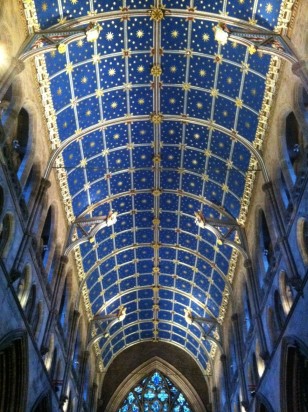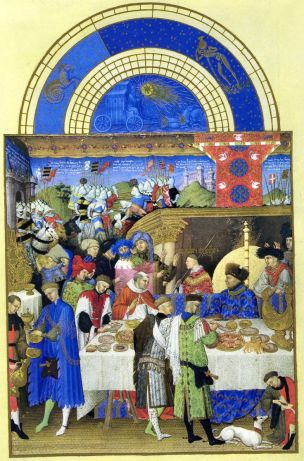Color in the Middle Ages
We often imagine the medieval world to be one of dreariness and monotony with little to recommend it in the way of color and aesthetic beauty. The default images in our mind’s eye are generally dominated by the earthy colors of stone, wood, and mud with a splash of blood and steel thrown in for atmosphere. Although it would be an overstatement to assert that this image is universally false—the life of a villien was far removed from that of the nobility—the fact of the matter is that the Middle Ages were a period awash in brilliant color and pattern well beyond what we would find fashionable today.
Much of what is left to us from the period are its buildings. As impressive as they are from an architectural standpoint—think of a sprawling stone castle or a soaring Gothic cathedral—from the outside they can appear somewhat harsh and dreary. But we must remember that we are seeing the results of centuries of erosion and modification. What is now a rough, gray stone castle would likely have been a gleaming white edifice visible for miles due to its coating of lime wash or plaster. In fact, the White Tower, the central keep in the massive set of fortifications now known as the Tower of London got its name from the lime coating that Henry III ordered for it in the 13th century. It wasn’t until the Victorians, who preferred the look of bare stone-work, that the practice was largely abandoned.
This type of embellishment would have been even more common in the interior of the building with nearly all the domestic rooms being rendered with lime and painted in bright colors. Furniture and textiles would have been similarly garish. Surviving evidence suggests that furniture was often brightly painted and paired with fabrics of complex design and color. Vivid tapestries would have adorned the walls and window and bed hangings would have been equally dazzling.
In the case of our cathedral, many of the gray stone statues and decorative exterior detail would have been picked out in vibrant colors, so very different from what we see today. Such treatment must have given the otherwise muted façade a sense of drama, whimsy and movement. So too its interior would have been a riot of brilliant color and design. Besides the stunning stained glass windows which we still marvel at today, the walls, ceilings, and even floors would have been covered in a variety of hues and intricate patterns. What remains to us today are the occasional painted ceiling, fresco, or partial tile floor. They can only provide a tiny glimpse of the overwhelming effect that must have been achieved when all the original design elements were intact.

This painted altarpiece at Toledo Cathedral gives us a glimpse of what the exterior of a medieval cathedral may have looked like (without so much gold leaf)

A light show at Amiens Cathedral attempting to replicate the building’s original exterior decoration

Painted roof boss in Winchester Cathedral with a partial restoration of the original paint on the rib vaulting (Note the intricate striped pattern)
This love of color carried over into art and fashion as well. It is no coincidence that the heraldic traditions that have been passed down to us are dominated by strong color and intricate patterns. Illustrations of the time show us a fantastic variety of styles and colors. Surviving jewelry indicates a strong preference for bright enameling and colored stones. Doubtless, today’s most committed fashionista could have found much to celebrate and enjoy in the world of medieval fashion.
So perhaps it is time to re-calibrate our imaginations when it comes to the medieval world. It’s fine to leave in the blood and steel for atmosphere, but try to throw in a bit more color and style for the sake of authenticity.















Absolutely beautiful illustrations, and the colours are amazing. I’m really impressed with the decor of Henry II’s bedroom – but all of the buildings, their interiors and the smaller items are wonderful. You’re right, we’re so used to seeing these things as they are after hundreds of years of erosion and decay. Lovely post, James.
Thanks, Millie. It’s always good to hear from you.
Jim
Thanks for some beautiful images, where is the fantastic fire place at the top if the article?
Thank you. The heraldic fireplace is located in the Chateau de Pontivy in Brittany. It is the ancestral home of the Ducs de Rohan.
Jim
Rupymaravala@gmail.com
Shocking amazing. Colours in 14th century wow